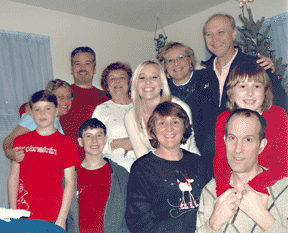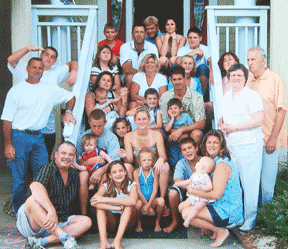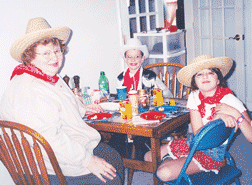|
|||||||||
Sandwiched Between Young and OldMothering takes on a new meaning when you’re caring for family in two generationsby Michelle SteelTerese Wells’ job demands long hours and superb organizational skills. On call around the clock, she needs to be prepared for anything. At times, it’s a scene from a three-ring-circus. “It’s hard to do something on the spur of the moment. Things we used to take for granted, like going away for a weekend, now take some planning,” said 45-year-old Wells. Yet she doesn’t bring home a paycheck.
Mothering her teenagers and her parents back to back, day in and day out is Wells’ full-time job. Baby boomers like Wells are by no means the first generation to mother in two directions — but they’re the first to coin a name for this stage of life. They’re the sandwich generation. “It has a lot to do with the baby boomers being movers and shakers their whole life,” said Tiffany Lundquist, Maryland’s spokeswoman for AARP, the Association for the Advancement of Retired People, an organization geared toward people 50 and older. Sandwiched in the MiddleIn 2006, sandwich generation won a spot in the dictionary. Merriam-Webster defines it as “a generation of people who are caring for their aging parents while supporting their own children.” How does a new word secure a spot in Webster? “The simple one-word answer is usage,” says Merriam-Webster spokesman Arthur Bicknell. “The word has to appear in a number of publications and isn’t ephemeral.” Syndicated newspaper columnist Carol Abaya added new layers to the term, club sandwich and open-faced, to recognize the varied situations of caregivers. Club-sandwichers come in two varieties. In their 50s or 60s, sandwiched between aging parents, adult children and grandchildren. In their 30s and 40s, sandwiched between young children, aging parents and grandparents. Open-faced sandwichers add a variety of complications. Wells is a typical sandwicher. By 2001, when Wells’ father, Jim Oliver, 83, was diagnosed with Alzheimer’s disease, her mother, Charlotte Oliver, 78, faced a number of ailments. Wells first looked into assisted-living facilities. But they had separate wings for people with Alzheimer’s. Separation didn’t fit the bill for her family, who valued closeness. Their only daughter proposed — and her parents agreed — that they leave their home in Bucks County, Pennsylvania, and move into an in-law addition built onto the Wells’ Prince Frederick home. “Everyone has their own space,” Wells said. Her parents even have their own mailbox and address. In the beginning, the family dinner table was set for six and everyone ate together. In ever-changing degrees, interdependence complements independence. Like Wells, one in eight Americans now juggles caring for both children and parents. Most of the aging parents in need are women, many widowed and living alone. It’s also women — many mothers ranging in age from their 30s to 60s — who are most likely to find themselves sandwiched. “Often, I’m pulled both ways between my kids and my parents. It’s been challenging and I’ve had to sacrifice activities with my kids. But for me, it was the right thing to do at the right time,” said Wells. “Families take care of families.”
Sandwich MakingsIn the big picture, it makes sense that sandwich generation joined the lexicon in 2006. People are living longer today. A Pew Research Center study said that 71 percent of today’s boomers — people born between 1946 and 1964 — have at least one living parent. That’s an 11 percent increase from 1989. Other sandwiching factors: Women make up a larger part of the work force now than a generation ago. Couples are waiting longer to have children and are having fewer children. Plus, care-giving for pay is a shrinking occupation — due in part to low wages. Furthermore, according to the Pew Research Center, the United States isn’t training or recruiting enough geriatric care specialists to meet the needs of a rapidly aging population. And we are rapidly aging. U.S. Census Bureau projections indicate that by 2030, the number of Americans 65 or older will double, to 71 million, about 20 percent of the population. Money is another ingredient in the sandwich. Care for an aging parent is expensive: A private room in a nursing home costs an average of $6,266 a month. Care in an assisted living unit costs about $3,000 a month; and home health aides cost an average $19 an hour, according to AARP. For many families, that’s not pocket change. “There’s an institutional bias the way social funding is available,” AARP’s Lundquist explains. “With Medicare, most of the funding goes into the facilities rather than in the pockets of the caregivers, who need it most.” Costs make the decision for many sandwichers. The Loaded SandwichLike Wells, Carol Naddell, 45, of Huntingtown found herself sandwiched. Naddell grew up in a large, close family that stuck together through thick and thin. She was especially close to her father, John Kempf. So when her father was diagnosed with Alzheimer’s disease, it was her time to pay back. Naddell and her five siblings made a pact to give their mother, 73-year-old Mary Jane Kempf, the gift of time. Looking after her father, Naddell was also helping her mother, who had the time to step out and pick up dry cleaning, handle banking business and shop for groceries. It also brought companionship to her mother, who was losing her husband of 52 years. “Knowing that I could have gone to my dad for anything growing up made me feel good about helping him,” said Naddell. When John Kempf broke his hip, still more help was needed. He had to be lifted and moved from the bed several times a day to prevent bedsores. Naddell and her five siblings banded together, each taking a day a week to trek the 45 minutes back and forth to their parents’ home in Prince Georges County. The plan succeeded because all the children had flexible schedules, working for themselves or at home. “We were really lucky when it came to our work schedules,” said Naddell, who’s the financial go-to of her husband, who is self-employed in real estate. “That was a huge stress reliever.” But there were stresses at the other side of the sandwich. “There were times I had to ask my seven-year-old son to keep an eye on my 72-year-old dad when we went to the mall and I’d have to run in to a store quick. I never knew when dad would wander off and it was hard for my son to understand what was happening and why he had to watch him,” Naddell said. It was also tough on her children when Naddell went to visit her dad in the evenings. The youngest two didn’t understand why they couldn’t tag along; the oldest two got angry that she wasn’t there for them. Naddell knew no other way. “It was quality time that I may not have spent with my dad otherwise,” Naddell said. “So I was moving forward and backward at the same time.” The Brown BaggerThere’s no vacant slot for my mother’s toothbrush. It sits in a Tupperware container stashed in zip lock baggies alongside travel-size toiletries: a makeshift home for the simple comforts of life. “I’ve waited to live in Calvert County for 20 years. I just never thought it would be this way,” says 69-year-old Margie Bednarik. There’s no place like home. The words spoken by Dorothy in The Wizard of Oz have loomed over my mother for two years. She’s capable of living on her own. But a divorce that’s been dragging on longer than she expected has sent her seeking shelter. Frazzled by teen-crazed chaos, I’ve managed to bring a small piece of calm into her life by squeezing out a space in my one-size-too-small home. She’s now a temporary boarder in my home. She roams with a trunk full of her basic necessities — clothes, legal documents and personal possessions — from place-to-place: my home, my sister’s and relatives. My youngest son is still willing to share his bedroom with her at a time in his life when privacy rules. She sleeps in a trundle bed alongside him. Her clothes hang inside his closet full of clutter: Monopoly, baseballs, school papers and art supplies. In a Dagwood sandwich of young and old, a two-by-four space is cleared on his dresser for her calendar and family photos. I struggle to find a comfortable way of life for her as she shares our bathroom with pimple medication and Mennen deodorant and a laundry room with grass-stained jeans, football jerseys and sweat-ringed T-shirts. “I don’t mind. At least I have a place to call home even if I know it’s temporary,” said Bednarik. Envious friends tell me how lucky I am to have the live-in luxury of a free housekeeper, gourmet cook and taxi-driver. I cringe thinking about how she should be on a cruise ship somewhere exotic, enjoying the companionship of others of AARP age. Or boating the Bay with friends. Or baking lasagna in her own kitchen. Coming from a lineage of strong Italian women, she has kept our family together all my life. I admire her independence and wait with her for the day she finds it again. “It will be a bittersweet day when I leave your nest for mine, but I’m grateful for the time together and your family welcoming me into your home with open arms,” my mom recently told me. The Price of BreadSandwiching sometimes sticks spouses and children between the slices. Naddell’s children and grandchildren watched John Kempf’s deterioration and finally his death in 2007. “I think it was toughest on the grandkids to watch Pop get worse,” Naddell said. “They were young and didn’t understand what was happening.” Wells’ children, who are 16 and 14, help with their grandparents now. “When they were young, everyone got all dressed up and had a tea party every day after school,” said Wells. “That’s changed over the years.” “I really try to put my kids first, but that doesn’t always happen,” Wells said. Struggling to fit everything — including volunteering at school and extra-curricular activities — into a tight schedule adds a new topper of stress to Wells’ sandwich. Spouses are sandwiched, too. Naddell’s husband — and her siblings’ husbands and wives — switched roles. While Naddell and her brothers and sisters were taking care of their father, the spouses were back home filling in the void by cooking dinner for the kids, running them to sporting events and making sure homework got done. I saw a bit of the accumulating stress when I visited the Wells and Olivers to take photographs. Wells’ mother got so excited that she fell and hurt her head. As they debated taking her to the emergency room, Wells’ father, Jim Oliver, held my hand. He took my hand again as I was leaving and walked with me to my car. When Wells’ husband asked his father in-law to let go, the older man refused. Then Wells called me back inside. Her mother insisted on telling me the story of how her husband, who hadn’t remembered her name since Christmas, called to her by name when he saw a newspaper ad for Mother’s Day. He gave the paper to her, pointing out the flowers in the picture as his gift. Through it all, the teenaged kids looked bored, blocking out the chaos. There are other costs, as well. Seven to 10 million sandwichers care for a parent separated by many miles and even states. “Long distance is an added stress and one more worry,” Lundquist said. Separation equals lots of travel. The expenses add up quick. “I struggled when my mother was living in Florida. I took a lot of trips back and forth. It was a relief when she finally moved down here,” said Barbara Buchleitner, spokeswoman at Anne Arundel County Aging and former long-distance sandwicher. She and her sister took turns, which relieved the stress a little. The 9-to-5 sandwicher must also balance jobs with parenting children, mothers and fathers. Going in late, leaving early, recruiting flexible schedules, cutting back hours or extended leaves often go with the new role. So do sacrifices of promotions or travel.
Cutting off the Crusts“It’s push and pull for the sandwich generation,” Buchleitner said. Wells decided she needed an extra pair of hands for help. She’s hired a part-time caregiver. “I needed to get my life back,” Wells said. Many local resources relieve the pressure for sandwiched mothers. The starting point for support and information are county offices on aging. Calvert: 410-535-4606; 301-855-1170. Anne Arundel: 410-222-4464. For long-distance sandwich mothers: Eldercare Locater @ 800-677-1116. Websites like www.thesandwichgeneration.com give support with the click of a button. There you’ll find an online survival course for sandwichers created by syndicated columnist Abaya, who learned by caring for her own aging parents. Senior Centers in both counties and across the nation offer relief to sandwichers in addition to support and a smorgasbord of activities for aging parents: recreational, leisure, physical fitness, educational and nutritional. Wells looks to the Calvert Pines Senior Center, a community within a community, for extra help. There, Charlotte Oliver and other seniors busy themselves with games like Bunco, Texas Hold ’Em, the Trail Blazers walking club, sock hops, feng shui gardening, the Scribbler’s writers’ group and the Elephant and Donkey political discussions. “There are three of me,” said Ann Newton, social services coordinator at Calvert Senior Pines Center in Prince Frederick. Her team includes Elizabeth Leclair, who travels between North Beach and Lusby’s centers, and Tunya Taylor who works out of Prince Frederick’s office. Their support group, People who Care, gives information, advice and education to sandwiched mothers and other caregivers in similar situations. The team meets the morning on the first Wednesday each month from 10:30 to noon. “The idea is not to go in there crying but to go in there feeling like you’re on top of your game,” Newton said. “They engage in learning from each other.” All three Calvert centers are looking to start a local chapter of ROMEO, a group already active from San Jose, California, to India. It’s not as romantic as the name might imply. Retired Older Men Eating Out brings together retired men aged 50-plus for good food and fun. There’s help for more needs than many stressed sandwichers imagine. Wells also finds help in Meals on Wheels. Across the nation, Meals on Wheels helps by delivering nourishing meals to people’s doorsteps. In Calvert, Meals on Wheels is a non-profit working in conjunction with Calvert Counties Office on Aging. One meal is delivered, Monday through Friday. Special dietary needs such as diabetes are met. The base cost is $4.25 per meal, adjusted to the eater’s income. “It just made things a little easier for me and was one less thing I had to plan in my day,” says Wells, who has used Meals on Wheels when she had to be gone and wanted to make sure her parents ate a good lunch. Of the five million Americans with Alzheimer’s or a related disorder, 50 percent may wander (like Naddell’s dad often did). The Personal Emergency System uses an electronic tracking system to locate lost people as well as give a lifeline to helpless people. To activate emergency help, they press a small, lightweight activator, generally worn around the neck. Calvert’s three senior centers run a Home Helpers system out of the Calvert Pines Center in Prince Frederick ($32/month: 866-517-8488). Comfort FoodSandwiching has its stresses, but it also offers rewards. You might find yourself down a two-way street with rewards waiting at both ends. Taking care of someone who took care of you for so long feels good. And sometimes, as at my home, grandma and grandpa can help out with the kids, too. And my mother contributed to me with her strength, concealed independence, positive outlook on life and her willingness to share and tell her own story — all the while helping to keep my teens occupied while I researched and wrote. As I was writing, my friend Dee Horvath showed me a Mother’s Day keepsake from her daughter a quarter century ago: Without her, the framed legend reads, the family drifts. No one can take the place of the eyes that have seen it all, the hands that reached out and healed, the very presence that brought you comfort and stability just by being there. Of all the roles we fill in life, being a mother is one that has no expiration date.
|
|||||||||
|
|||||||||
|
|
|||||||||
|
© COPYRIGHT 2008 by New Bay Enterprises, Inc. All rights reserved.
|
|||||||||
 Volume 16, Issue 19 - May 8 - May 14, 2008
Volume 16, Issue 19 - May 8 - May 14, 2008


